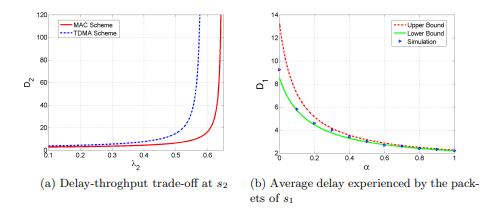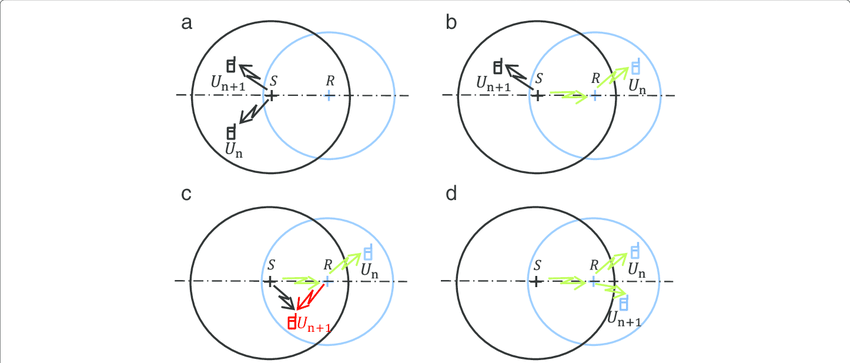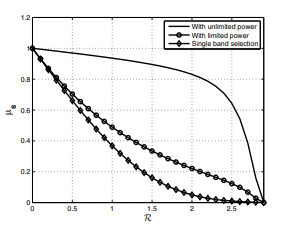Breadcrumb

Using network coding to achieve the capacity of deterministic relay networks with relay messages
In this paper, we derive the capacity of the deterministic relay networks with relay messages. We consider a network that consists of five nodes, four of which can only communicate via the fifth one. However, the fifth node is not merely a relay as it may exchange private messages with the other network nodes. First, we develop an upper bound on the capacity region based on the notion of a single-sided genie. In the course of the achievability proof, we also derive the deterministic capacity of a four-user relay network (without private messages at the relay). The capacity achieving schemes
On spectrum sharing between energy harvesting cognitive radio users and primary users
This paper investigates the maximum throughput for a rechargeable secondary user (SU) sharing the spectrum with a primary user (PU) plugged to a reliable power supply. The SU maintains a finite energy queue and harvests energy from natural resources and primary radio frequency (RF) transmissions. We propose a power allocation policy at the PU and analyze its effect on the throughput of both the PU and SU Furthermore, we study the impact of the bursty arrivals at the PU on the energy harvested by the SU from RF transmissions. Moreover, we investigate the impact of the rate of energy harvesting
Impact of nonzero boresight and jitter pointing errors on the performance of M-ary ASK/FSO system over Málaga (M) atmospheric turbulence
In free-space optical (FSO) communication, Distribution models such as lognormal, gamma-gamma, and k-distribution describe weak, moderate, and strong turbulence, respectively. Whereas Málaga (M) distribution is a powerful statistical model repeatedly mentioned in the literature due to its generality, Málaga (M) describes the three turbulence conditions while considering the pointing errors, represented by the jitter boresight displacement, of the communication beam. Exact and closed-form expressions for symbol error rate and outage probability are presented in this paper—furthermore, cases
On the Degrees of Freedom of the Two-Cell Two-Hop MIMO Network with Dedicated and Shared Relays
We investigate the degrees of freedom (DoF) of the downlink of a cellular relay network. In this network, two base stations transmit to two mobile stations via relays due to the absence of a direct communication link. Each base station and mobile station is equipped with M antennas. Each base station has two messages; one to each mobile station, and uses two relays to transmit to the mobile stations. The relays are half duplex, decode-and-forward and equipped with N antennas each. We consider two configurations of the relays; shared and dedicated relays. In the shared relays configuration, the

Stability and delay analysis for cooperative relaying with multi-access transmission
We consider a cooperative relaying system with two source terminals, one full duplex relay, and a common destination. Each terminal has a local traffic queue while the relay has two relaying queues to store the relayed source packets. We assume that the source terminals transmit packets in orthogonal frequency bands. In contrast to previous work which assumes a time division multi-access cooperation strategy, we assume that the source terminals and the relay simultaneously transmit their packets to the common destination through a multi-access channel (MAC). A new cooperative MAC scheme for

Adaptive training-based collaborative mimo beamforming for multiuser relay networks
In this paper, we consider a cooperative relaying scenario with multiple sources transmitting to one or more destination nodes through several relay terminals. Each relay is equipped with multiple receive and transmit antennas. We assume that the relays can estimate their uplink (relay-destination) channels with enough accuracy and that they have access to the training sequences transmitted by the sources. We present two adaptive training-based algorithms for multiuser relay beamforming. Both algorithms use Kalman filtering to estimate the beamforming matrices iteratively. The first algorithm
Hybrid ARQ-CQI Feedback-Based Access Scheme in Cognitive Radio Networks
In this paper, we consider a cognitive radio (CR) network where the primary network's feedback information is utilized to develop an access scheme for the secondary network to exploit the underutilized primary spectrum resources. Secondary users (SUs) identify the spectrum opportunities by sensing the spectrum for primary users (PUs) activities and by listening to the PUs feedback. The feedback signals monitored in this research work are the channel quality indicator (CQI) and automatic repeat request (ARQ) available in the PUs network. For detecting the PUs activities, SUs employ soft energy

Effective area spectral efficiency metric for decode-and-forward cooperative wireless communications
In this paper, we introduce a new metric, namely: effective area spectral efficiency (EASE), to quantify the spectral efficiency as well as the spatial properties of decoding and forward (DF) relaying wireless communications networks with interference management. The EASE metric is based on the average affected area, the average ergodic capacity, and a new introduced index, namely: source relay communication index (SRCndx). We derive a closed-form expression for the maximum transmission range under Rayleigh fading environment. Based on the maximum transmission range, we define and derive the

Spectrum-aggregating cognitive multi-antenna user with multiple primary users
We investigate a cognitive radio scenario involving a single cognitive transmitter equipped with K antennas sharing the spectrum with M primary users (PUs) transmitting over orthogonal bands. Each terminal has a queue to store its incoming traffic. We propose a novel protocol where the cognitive user transmits its packet over a channel formed by the aggregate of the inactive primary bands. We study the impact of the number of PUs, sensing errors, and the number of antennas on the maximum secondary stable throughput. © 2014 IEEE.

Advance Artificial Intelligence Technique for Designing Double T-Shaped Monopole Antenna
Machine learning (ML) has taken the world by a tornado with its prevalent applications in automating ordinary tasks and using turbulent insights throughout scientific research and design strolls.ML is a massive area within artificial intelligence (AI) that focuses on obtaining valuable information out of data, explaining why ML has often been related to stats and data science. An advanced meta-heuristic optimization algorithm is proposed in this work for the optimization problem of antenna architecture design. The algorithm is designed, depending on the hybrid between the Sine Cosine Algorithm
Pagination
- Previous page ‹‹
- Page 21
- Next page ››
